Ditrysia
| Ditrysia | ||||||||||||
|---|---|---|---|---|---|---|---|---|---|---|---|---|

Epicallima formosella , a representative of the rotten wood moth . |
||||||||||||
| Systematics | ||||||||||||
|
||||||||||||
| Scientific name | ||||||||||||
| Ditrysia | ||||||||||||
| Borner , 1925 |
Ditrysia is a taxon of the butterflies (Lepidoptera) from the suborder Glossata . Despite the splitting off of five superfamilies within the common taxon Heteroneura , it probably includes almost 99% of all known butterfly species. The remaining five superfamilies of the Heteroneura are occasionally regarded as sister taxons with the name Monotrysia to the Ditrysia. However, the monophyly of these is doubtful. It only seems certain that at least the Ditrysia and the Tischerioidea form a monophylum.
features
Although the Ditrysia group is extremely species-rich, the species are quite similar in their physique, which makes it difficult to decipher their relationship. The Ditrysia are delimited by the following autapomorphies : The mating opening ( ostium bursae ) is separated from the laying opening ( Oviporus ) , as is the case with the Exoporia . With the Ditrysia, however, the two are linked. On the second sternum of the abdomen, protruding apodemes are formed on the inside and the musculature of the pterus is arranged in numerous short bands instead of long fibers.
A number of the superfamilies, especially the basal groups, have conspicuous but plesiomorphic features that also occur in most taxa outside the Ditrysia. As a rule, they are small moths with a wing vein CuP that is clearly pronounced, at least on the hind wings . However, this feature has disappeared in some subtaxa. The caterpillars of these species develop inside the plants and have rings of hooks arranged in a circle or oval on the belly legs . Together with the taxa outside of Ditrysia, these otherwise not closely related butterflies are known as small butterflies (Microlepidoptera or “micros”) for practical reasons .
Systematics
In the recent past, some subtaxa of the Ditrysia were further divided, so that 33 superfamilies are currently assigned to the taxon.
- Superfamily Gracillarioidea
- Superfamily Tineoidea
- Superfamily Yponomeutoidea
- Superfamily Gelechioidea
- remaining superfamilies: Apoditrysia
Molecular phylogenetic study (March 2013)
A large-scale study published in March 2013 examined the order of butterflies for kinship relationships. In this study there are some differences to older classifications with regard to Ditrysia. Douglasiidae and Millieriidae are classified in Apoditrysia . Lypusidae is classified in Gelechioidea and Gelechioidea is located in Obtectomera . Tineoidea and Gracillarioidea are not listed because they turn out to be non- monophyletic . Their families are listed individually.
The cladogram for Ditrysia is as follows:
| Ditrysia |
|
||||||||||||||||||||||||||||||||||||||||||||||||
|
|
supporting documents
Individual evidence
- ↑ a b c d Niels P. Kristensen: Lepidoptera, moths and butterflies . In: Maximilian Fischer (Ed.): Handbook of Zoology . 1st edition. tape 4 - Arthropoda: Insecta , volume 35. de Gruyter, Berlin / New York 1998, ISBN 3-11-015704-7 , p. 12 ff . (English).
- ↑ Jerome C. Regier, Charles Mitter a. a .: A Large-Scale, Higher-Level, Molecular Phylogenetic Study of the Insect Order Lepidoptera (Moths and Butterflies). In: PLoS ONE. 8, 2013, p. E58568, doi : 10.1371 / journal.pone.0058568 .
literature
- Niels P. Kristensen: Lepidoptera, moths and butterflies . In: Maximilian Fischer (Ed.): Handbook of Zoology . 1st edition. tape 4 - Arthropoda: Insecta , volume 35. de Gruyter, Berlin / New York 1998, ISBN 3-11-015704-7 (English).